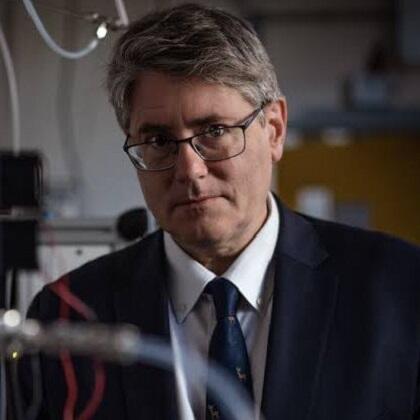London’s Air: The 70th Anniversary of the Great London Smog
Share
- Details
- Text
- Audio
- Downloads
- Extra Reading
On the 5th of December 1952 London experienced a major pollution episode, the Great Smog, resulting in thousands of deaths throughout the city.
On the 70th anniversary of this event, the lecturer will review how air pollution has changed in the intervening period, the evidence that it is still having profound effects on our health and the effectiveness of measures to ensure clean air and better public health.
Any Further Questions? Podcast
Listen to our follow-up podcast with Professor Mudway via the Audio tab or on Spotify & Apple
Download Text
London’s Air: The 70th Anniversary of the Great London Smog
Professor Ian Mudway
5th December 2022
The 5th of December 1952 was bitingly cold, a mass of cold moist air was trapped over London. It was foggy, there was little wind and so slowly 70 years to the day all the emissions from London’s Coal powered power stations and from every chimney in London slowly accumulated over the city, blanketing the population in a yellowish toxic smog. Thousands died, and more fell ill. It is not on reflection something to celebrate, but today perhaps what I want to do is memorialised the five days London chocked and coughed, and spluttered beneath this blanket of pollution, and to reflect on the human cost, the lessons learnt and often forgotten, and to remember the 12,000 individuals who lost their life due to this event and the 28,000-36,000 whose lives will be cut short this year because of poor air quality across the UK. But before considering the past, I think it is worth considering the future and the fact that even today globally outdoor air pollution contributes to the early deaths of over 4 million people per year; it is estimated that 99% of the world’s population lives in areas failing to meet the WHO guideline concentrations for air pollution. Including London, so whilst London’s air has undoubtedly improved over the last 70 years, there is still much to be done to protect the public’s health,
Air pollution did not suddenly occur for the first time in London in December 1952. As the city grew rapidly throughout the 19th and early 20th centuries and became more industrialised and densely populated, pollution from industry and domestic dwellings became a common feature of daily life, particularly during the winter months. Literature abounds with descriptions of London’s peasoupers, smoke-laden streets and artists of the time captured images, beautiful in their own way, but depicting London’s air pollution. At the time there simply was not a widespread appreciation of the impacts of smoke on human health. Some even argued that it was curative against London’s infectious air and when it was discussed in the context of health, there was more focus on how it obscured light in the city and how this could contribute to rickets or TB.
Neither was the London smog of 1952, the first significant air pollution episode where impacts on human health were noted. Between December the 1st and 5th 1930, within the heavily industrialised Meuse Valley in Belgium a dense winter fog trapped emissions at ground level for 5 days; resulting in several thousand cases of illness and 63 deaths, largely from respiratory causes. Due to a similar (albeit less severe) incident that occurred in a nearby valley in 1911, killing off many cattle, many farmers in the Meuse Valley fled to the hillside during the first two days of the smog to reduce livestock casualties. We will return to cows in due course. The subsequent investigation into the event made ominous warnings of the potential impact if such an event were to occur in a major city. It was estimated that a similar event in London could kill as many as 3,200 individuals. Another number to hold onto. A memorial to those who died during the event was subsequently erected.
Post-mortem examinations of the victims of the fog showed pronounced oedema; liquid filling the alveolar spaces in the lungs associated with inflammatory cell infiltration, and injury to the cells lining the airways.
The second major event -or potential early warning that should have highlighted the potential impact of air pollution on health, occurred 18 years later in Donora (October 1948), Pennsylvania, an industrial, steel and zinc manufacturing town, in a valley south of Pittsburgh. Again, the weather contributed to a two-day smog event associated with many cases of respiratory distress and 18 deaths, in a population of only 18,000. Again, this event is memorialised in Donora, where it catalysed action toward the establishment of clean air laws.
There was, therefore, plenty of warnings that smogs could have a significant burden on health, but the London Smog has its place in history for being the first mass population event where the true health impacts of air pollution were studied in detail. The details are well-known. On the 5th of December 1952, cold weather, low winds, and a temperature inversion trapped a blanket of cold moist air over the city and conspired to trap all of London’s coal-burning emissions over the city for a period of 5 days. But there were also underlying economic complexities. The quality of the coal in London was poor, with high sulphur content as high-quality coal was being shipped to external markets, due to the UK’s perilous economic state post war. This resulted in the rapid build-up of high concentrations of black smoke (soot, or elemental carbon) and the gas SO2 over the city, peaking between the 7th-8th of December before dispersing on the 9th-10th as the wind picked up. This episode of pollution was associated with a rapid increase in the number of daily deaths, which closely tracked pollutant levels. During the day episode, it is estimated that there was an excess of over 4,000 deaths, but a careful examination of the graph clearly shows that death rates did not turn to normal daily death rates for a significant period, implying a potential lag in the health effects. Considerable work has gone into attempting to understand the total number of attributable death both during and after the episode, complicated by the concurrent presence of an influenza outbreak, but it is now estimated that around 12,000 deaths occurred.
Visibility was poor, particularly within the Central London boroughs, and London came to an effective standstill. It wasn’t safe to drive, cinemas were closed due to the infiltration of the smog indoors, and sporting fixtures cancelled, but in reality, there was no escape. At the time houses were not well insulated and the smog penetrated all environments, added to which the cold weather meant that indoor air pollution from open fires indoors was significant. What I find amazing is how little attention was paid to the potential health impacts; people were coughing and struggling to breathe in the streets, but the newspapers focused on the economic costs, the associated crime spree, or incidental stories such as the death of livestock at a show at Spitalfields Market. Less attention was placed on the added burden on the health service, the mortuaries running out of space, and the challenges faced by undertakers processing the large numbers of people dying throughout the city.
The problem with all these black-and-white photographs is that they lack a sense of immediacy. When I was listening back to old BBC recordings concerning the smog, one journalist stated that “London coughed and crawled almost to a standstill in a murky yellow gloom”, reflecting the concentration of sulphur dioxide in the air, and for all my years of lecturing on the topic, I had never really appreciated this aspect of the event. Fortunately, however, I then came across four colour photographs from the event, showing just this and I think this vividly illustrated it.
The next question is who died? The common narrative is that it was the very old with significant pre-existing disease, but even a relatively crude examination of the data highlights a significant increase in death rates between the week before and after the event, in groups over 45 years of age and infants under one year, and these underlying statistics were well known even shortly after the event – provide health statistics delivered to the Greater London Council – 3rd Feb 1953.
On the 50 anniversaries of the Clean Air Act, a number of papers were published, reevaluating the health statistics. But perhaps the most impactful was the pathological examination of pulmonary autopsy samples from casualties of the smog. These show several key issues. First that the soot itself represented an aggregate of much smaller particles with high metallic content, and second that the pulmonary tissue was infiltrated with carbon-loaded pigmented macrophages, demonstrating how the inhaled PM during the episode was triggering inflammation and tissue injury / remodelling.
With such stark evidence, one might expect this to have catalysed the Government of the day to act, but in reality, air pollution was nowhere near the top of the political agenda post war. This can possibly be surmised from a quote attributed to Harold Macmillan [quote] made before the smog event, in response to concerns about air quality. This issue was complex, intersecting with a broad range of other concerns, some economic, some political, and some simply related to the perception that most of the population would have no appetite for the necessary regulation: “an enormous number of broad economic considerations that have to be taken into account.”
Nether-the-less, or perhaps as predicted, a committee was formed to review the evidence arising from the London smog and to propose actions to mitigate urban pollution. The Beaver Committee reported back on 25 November 1954 with a series of recommendations including, “Radical changes”: mandated movement toward smokeless fuels, especially in high-population ‘smoke control areas’, a new National policy – looking five years ahead; changes to the location of power stations, new equipment, and a plea for additional research. These recommendations did not at first make it onto Government business, rather they were taken forward initially as a private members bill, by the rather colourful Conservative politician Gerald Nabarro. This ultimately gained support from the Government, which lead to the introduction of the Clean Air Act in 1956 [details of the provisions within the act].
As a consequence of the Clean Act of 1956 and the subsequent amendments in 1968 and 1993, air pollution dramatically improved throughout the UK. There were still significant smog events over this time in 1956, 57, 62,75, 82, 91, but these were less significant and had a much smaller acute health impact.
Throughout the 70’s and 80's, air pollution slipped down the list of political and scientific priorities. To a large extent, legislation and associated regulations were thought to have solved this issue. However, research from the US in the mid-1990s challenged this view, with evidence that long-term exposure to historically low levels of particulate pollution was still driving significant health effects. The seminal study examined the probability of populations living in six cities with dramatically different air pollution climates surviving over a 14-year period and found that individuals in more polluted cities had a greater probability of dying earlier.
When adjustments were made for occupation, smoking history, and deprivation, they found an underlying linear association between the risk of early death and long-term exposures to PM2.5, with evidence that the excess deaths were arising from COPD, pneumonia, and cardiovascular disease. It was this study which really highlighted the impact of long-term air pollution exposures on cardiovascular health and demonstrated that the impact of air pollution was felt beyond the lungs.
Subsequently, by applying global models of PM2.5 exposures to the observed effects in this and similar studies, it has been possible to estimate the number of early deaths globally, which for outdoor air pollution is currently estimated at over 4 million. There is however a danger in focusing solely on death because air pollution will also impact on the severity of pre-existing diseases and have significant impacts on the quality of one’s life as they age, or across their life, if they are particularly vulnerable, for example, if they are asthmatic. But perhaps the key issue that is sometimes missed is that what these data indicate is that air pollution is not simply a trigger for symptom exacerbation or death, but that there is very good evidence that it is causally related to the development of disease and that many of these early impacts are sub-clinical or silent, such that the air you breath today may have impacts much later in life. In much the same way that a smoker doesn’t roll over dead from a single cigarette, but the cumulative injury experienced by the lung and cardiovascular systems over many decades finally leads to respiratory and cardiovascular disease.
As we’ve said as we entered the 1990s, the focus shifted more to long-term exposures to fine particles, but within this very broad classification, there was a particular focus, especially in Europe on traffic emissions and specifically diesel exhaust emissions.
Whilst diesel exhaust PM represent only a relatively minor fraction of PM2.5, even near roadside, there was emerging evidence that they were associated with adverse health effects. Asthma symptoms were worse in children living near busy roads and experimental exposure of healthy individuals to diesel exhaust was shown to drive both inflammation in the lungs and systemic circulation.
These effects could also be replicated under real-world conditions. In the Oxford Street study, groups of mild and moderate asthmatics were asked to walk up and down Oxford Street for 2 hours, as well as around the round park in Hyde Park on two separate occasions. The first representing a high diesel site, the other a more background urban environment. The authors found that there was an acute, but sustained reduction in lung function in the asthmatics following their walk along Oxford Street and that this was associated with a marker of inflammation in their central airways, myeloperoxidase, samples by induced sputum.
These however are acute responses, eliciting very minor symptoms, the subjects taking part in these studies are not even aware of. The more significant question is what the impact of living over a long period of time in an area of poor air quality is. The picture here was taken back in March 2011 of an NO2/fine PM episode in Central London. At the time I was involved in a study addressing the impact of air pollution on children’s lung function, at the end of which we found that at the age of 8-9 years, children had lost on average about 100-120 mL of lung volume due to the traffic-related pollution where they lived. These effects were small, probably more of an indication of adverse effects that would contribute to increased vulnerability to chronic disease as the children age, but for some individuals, the impact of this pollution at the time was devastating. In February 2013, Ella Adoo-Kissi-Debrah died from an asthma attack. It took until 2021 for the Coroner Phillip Barlow to rule that air pollution "made a material contribution" to her death, but this was a landmark ruling. To have air pollution on the death certificate underlined that air pollution impacts are not just felt in dry statistics, but are measured by loss and grief.
The impacts are still evident in our city today, air pollution at current levels is still associated with excess deaths, worsening asthma symptoms, and adverse cardiovascular outcomes. Recent evidence has begun to show impacts during pregnancy, impacts on the brain, both in terms of mental health and dementia risk, so whilst pollution continues to fall and seems historically low, or low in comparison to internally other cities there is still a significant burden and this is felt across the life course from before cradle to near death.
But all is not gloom and doom.
There is substantial evidence that actions that reduce air pollution deliver real health benefits, not just longer lives, but longer years of healthy productive life. To illustrate this, we can revisit the original six-cities study, where federal and national air quality regulation reduced pollution in the six cities in the period after the original study, and where in every case, as long-term pollution fell so did the risk of early death.
Similarly in the Children’s Health Study from California, the adverse associations between lung volume with air pollution exposures fell with each subsequent longitudinal wave of the study, reflecting a reduction in air pollution in California. In both cases, the benefits accrued following the Clean Air Act regulation delivered better health, but also in the later case helped to prevent the accumulation of vulnerability within the population.
But regulation is challenging this and I’m reminded of Harold Macmillan’s statement that “an enormous number of broad economic considerations that have to be taken into account.” when considering action to tackle air pollution. This is live in London right now. London’s Ultra Low Emission Zone is designed to accelerate the adoption of lower-emission vehicles in London, with financial penalties for driving a non-compliant vehicle within the city. It was introduced in the centre of the city, with the old congestion charging zone in April 2019 and extended to the North and South Circular in October 2021. Only last week London Mayor indicated that the ULEZ would be extended to all boroughs in August 2023 and already there is significant resistance from the outer London boroughs. It is not my role as a scientist to wade into this political debate but only to provide evidence and to me that is simple. First, that regulation of traffic does reduce pollution (there are some caveats), second that it is clear that reducing pollution from traffic improves health and finally that most people in London are breathing pollution that they themselves are not responsible for, and that very often those most affected are already disadvantaged, don’t own cars and have the least agency to taking steps to reduce their exposures.
I’d also in closing like to reflect back to 1661, to the essay written by John Evelyn – Fumigation, on air pollution in London. It makes some prescient statements that remain valid to this day. That to reduce pollution you need cleaner fuels, that vulnerable populations should be separated from the main sources of pollution (not for example, encouraged to live in high-density blocks adjacent to London’s busiest roads) and that improving London’s environment in the round produces a better more productive economy. Throughout there is the sense that there is a moral imperative to deliver cleaner air – one might almost in modern parlance call it a fundamental human right, as now enshrined by the United Nations.
Finally, as a resident of South London, I like to leave you with a quote from Cicero. The picture is taken from Walworth Health Centre, it’s also the motto on Lewisham’s coat of arms: Salus Populi Suprema Lex – The Health of the People is the Highest Law. Particularly pertinent with Ella’s law, a New Clean Air Act having just passed through the Lords to the Commons.
© Professor Mudway 2022
Part of:
This event was on Mon, 05 Dec 2022
Support Gresham
Gresham College has offered an outstanding education to the public free of charge for over 400 years. Today, Gresham College plays an important role in fostering a love of learning and a greater understanding of ourselves and the world around us. Your donation will help to widen our reach and to broaden our audience, allowing more people to benefit from a high-quality education from some of the brightest minds.


 Login
Login







